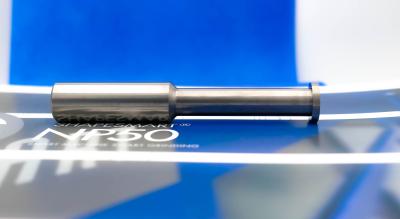
Rollomatic, a leading machine tool manufacturer based in Le Landeron, Switzerland, maintains its global leadership position in the field of pinch and peel grinding by developing a new process. Rollomatic is the original inventor of the pinch/peel grinding methodology and stays in the forefront in developing specific processes related to making this type of machine even more productive.
Pinch grinding offers accurate geometrical dimensions on the blank and tight surface finish requirements. In pinch grinding, the roughing and finishing wheels grind parts simultaneously, with the finishing wheel trailing the roughing wheel. The rough and finish grinding are performed in one pass. This innovative way to cylindrically grind parts eliminates separate processes and reduces cycle time.
Rollomatic developed an advanced process known as “double rough pinch grinding” which vastly decreases cycle times for blank preparation of the following carbide cutting tools:
- T‐slot cutters
- Thread endmills
- Rotary burs
- Endmills for die and mold machining
- Long‐reach endmills
- Repeatable process for long‐batch production.
- Both grinding stations are equipped with diamond wheels with a grit size which is normally used for rough grinding.
- The blank is then “pinched” between two rough‐grit diamond wheels.
- The wheels interact on the blank simultaneously in a synchronized approach. While one wheel does the majority of the work, the second wheel cleans up what was left from the other wheel.
- The surface finish on the blank is better than what would normally be considered an acceptable finish.
- The cycle time is a fraction of what it would have been using the customary pinch grinding method with roughing and finishing wheels.
Both grinding spindles are “synchronous direct‐drive spindles” with 19 hp peak each. The most important feature of a synchronous motor is that it provides constant speed during its operation and that the torque curve is highly efficient. The rotational force is not reduced with higher RPM’s. Synchronous motors always run at a speed equal to their synchronous speed, as opposed to asynchronous motors (induction motors) which always have a lag and are therefore less efficient.
On a test production run of 100 pieces, the following results were achieved:
- Cycle time without loading/unloading was 5 min. and 5 sec.
- Wheel spindle load on the roughing side (synchronous spindle) was no more than 35%. The limiting factor is the wheel wear and not the machine. The machine will always outperform the wheels.
- The highly efficient synchronous spindles, running at 35% power draw or less, do not release any heat into the machine or into the grinding process. This greatly improves the thermal stability of the machine.
- Synchronous spindles operate much quieter even under load compared to induction motors.
- An excellent G‐ratio was achieved which is the ratio between the stock removal and the wheel wear volume.
- The wheel wear was manageable. With the clean‐up pass of the 2nd wheel, the dimensional tolerances of the blank were easily maintained.
- There were no TIR issues and surface finish was above expectations.
- This process outperforms alternative competitive equipment by more than 50%.
Contact Details
Related Glossary Terms
- grinding
grinding
Machining operation in which material is removed from the workpiece by a powered abrasive wheel, stone, belt, paste, sheet, compound, slurry, etc. Takes various forms: surface grinding (creates flat and/or squared surfaces); cylindrical grinding (for external cylindrical and tapered shapes, fillets, undercuts, etc.); centerless grinding; chamfering; thread and form grinding; tool and cutter grinding; offhand grinding; lapping and polishing (grinding with extremely fine grits to create ultrasmooth surfaces); honing; and disc grinding.
- grit size
grit size
Specified size of the abrasive particles in grinding wheels and other abrasive tools. Determines metal-removal capability and quality of finish.
- total indicator runout ( TIR)
total indicator runout ( TIR)
Combined variations of all dimensions of a workpiece, measured with an indicator, determined by rotating the part 360°.

